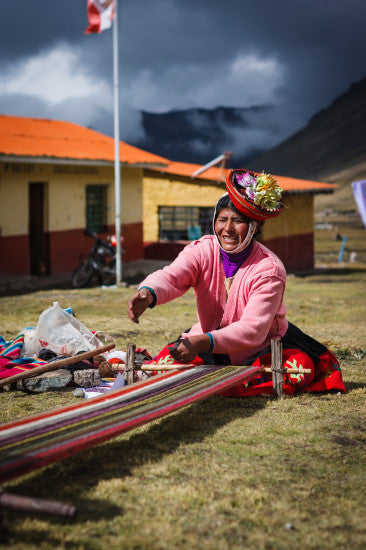I’ve spent the better part of the last six years working with traditional weaving in highland communities in Peru, and even though I’m intimately familiar with the basic backstrap loom techniques, the processes involved never cease to amaze me!
On a recent community visit, I watched a woman busily work on one of her weavings and I was completely enthralled – how quickly her fingers moved across the warp, picking up and dropping yarns in order to form a single row of woven fabric. Her movements were fluid, with no hesitation, even with multiple unique pallays, or woven patterns, to create. It was simply fascinating to watch. Having learned to weave myself just one (simple) pattern at a time, I’m continually impressed by these weavers’ ability not only to memorize a myriad of different patterns, but also to simultaneously and effortlessly flow from one pattern to the next in a given row of weaving, and not lose their place in the design.

Photograph by Isaiah Brookshire
To this point, I’ve only mastered weaving a chumpi – a narrow band featuring just one pallay; basically I’m at the level of a 10 year old girl! When I learned to weave, I learned by watching as most people in the weaving communities do, starting from a very young age, often just six or seven years old. My teacher – just a girl herself! – would weave the first repeat of a design and I would watch her intently, attempting to follow the pattern: which yarns to bring to the top and which to let drop to the back. Then, she would hand it to me and, working in part by memory and in part by counting, I would attempt to replicate her work by weaving the next repeat in the pattern. When I went to Chinchero one weekend to practise what I’d learned, I was quickly surrounded by a gaggle of schoolgirls asking me, “How many patterns do you know?,” eager to compare notes as they shared with me the ones they’d already mastered, and which ones were next on their list to learn.

Photography by Isaiah Brookshire
These patterns learned early on are fairly simple consisting of only maybe a dozen or so rows, making keeping track of one’s place fairly easy by counting or by memorizing the sequence. Some of the more advanced designs, however – including some of my favourites frequently featured in Threads of Peru textiles – are so complex, the idea of counting yarns in order to keep your place in the pattern – let alone memorizing the sequence – just seems impossible!
The work these weavers do, and the grace with which they do it, is truly astonishing, and the results – as evidenced by everything featured in these pages – are works of art of the highest order.
Post written by: Sarah Confer

